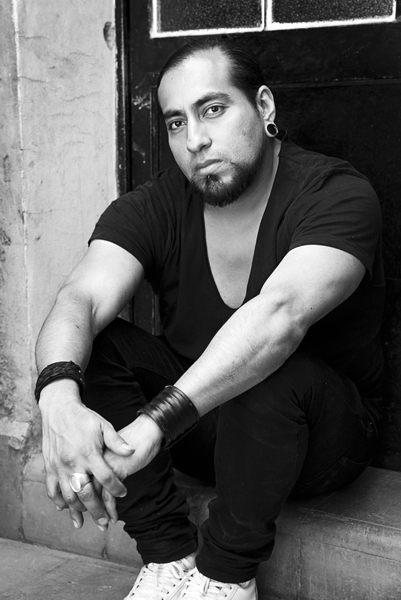
Olivia Shih: You first received technical jewelry training at the school of Design and Crafts (Mexican Institute of Fine Arts) in Mexico before enrolling at St Lucas University College of Art and Design Antwerp in Belgium for your master’s degree. How did this transition influence your work?
Jorge Manilla: My education in Mexico opened a world of possibilities. Those years taught me that a piece of classical jewelry acquires its value by the materials and techniques used, as well as by its aesthetic and wearability. When I learned how to make jewelry I started selling it straight away, but I often asked myself, why did I do it? Who did I do it for?
Soon after that, I decided to move to Belgium. A year of sculpture at the Academy of Art in Ghent was the perfect bridge to start my contemporary jewelry education. During that year, I started to think more deeply about ideas, concepts, and processes.
At St Lucas, I learned to make jewelry by not making jewelry. During that time I forced myself not to think about the portability of the piece; I stopped using precious metals, which I think was one of the most difficult things to do.

Olivia Shih: You first received technical jewelry training at the school of Design and Crafts (Mexican Institute of Fine Arts) in Mexico before enrolling at St Lucas University College of Art and Design Antwerp in Belgium for your master’s degree. How did this transition influence your work?
Jorge Manilla: My education in Mexico opened a world of possibilities. Those years taught me that a piece of classical jewelry acquires its value by the materials and techniques used, as well as by its aesthetic and wearability. When I learned how to make jewelry I started selling it straight away, but I often asked myself, why did I do it? Who did I do it for?
Soon after that, I decided to move to Belgium. A year of sculpture at the Academy of Art in Ghent was the perfect bridge to start my contemporary jewelry education. During that year, I started to think more deeply about ideas, concepts, and processes.
At St Lucas, I learned to make jewelry by not making jewelry. During that time I forced myself not to think about the portability of the piece; I stopped using precious metals, which I think was one of the most difficult things to do.
These years changed my way of seeing jewelry and I understood the difference between classic and artistic jewelry, what it was to work through a concept, how ideas were translated into materials. This is how my artistic language was born and developed.

How do you start a piece of jewelry? Can you talk about your process?
Jorge Manilla: Talking about my process is difficult because it varies depending on the concept and what I want to communicate. I don’t have a defined material, and I don’t like to use the same techniques often. With one project, I’ll start by reflecting and writing, and with the next project, I might start simply by experimenting with materials.
Process is very important to me. It’s important to have the experience of experimenting, creating, living, feeling materials and giving them form. Or even reading, writing, and translating my ideas into three-dimensional form.
I like the idea of building and rebuilding a piece—building a shape, idea, or material.

Jorge Manilla: Most of these are organic materials, and I think each has its own visual and symbolic strength. I am interested in the feel, temperature, and texture of these materials.
It is important to say I don’t always choose the materials; I allow materials to cross my path, and I let them live with me—I see them, touch them, move them, and then transform them.
Much of your work is in conversation with religion and the painfully complex relationships people have with it. Can you talk a little about your own experience with religion and the religious?
Jorge Manilla: I prefer not to talk about my religion because in the end, I don’t let it influence my work; I keep them as two separate things.
My work is mainly focused on the phenomenon of religion and not the institutions. I am interested in people’s beliefs, actions, and rituals, and the interaction between the existent and nonexistent.
I am interested in how the human being is capable of surpassing the limits of physical pain to heal spiritually—how although these actions are physical and real, the final transformation happens in the mind.

Jorge Manilla: In fact, it’s not only in these series; I generally create a large volume of pieces.
Both series are inspired by Mexico City. Tales of a Big City represents the history of the people living in a city with a population of 25 million: their identity, their status as individuals, and their sorrows and joys. I translated my ideas into seal rings that represent a certain status, and I decided to substitute the precious stones with a hollow space so everyone can place his or her own story inside.
Pain is a sort of memento mori. The series makes reference to the violence devastating Mexico in recent years: the pain of each individual and the anonymity of the people who are victims in these general violent attacks.
In your work Common Memories, blackened necklaces hang from the ceiling, each a stark gesture against the white walls, while a trail of black dirt meanders on the floor. What inspired you to display jewelry in a manner that takes control of the space, transforming it into an alternate reality?

Jorge Manilla: The setup of my work in general is as important as the work itself. In this case, the white space in Platina Gallery played an important role. By placing dirt on the floor, we formed a type of frontier, a line between the public and the pieces. It is work that speaks of love and heartbreak, of difficult and dark times in our lives, and this line gave people the opportunity to cross it or not.
This may seem like a blunt question, but why jewelry? What is it about jewelry that makes the most sense to you as an artist?
Jorge Manilla: I became a jeweler by accident. But inside this accident I discovered a new phase in my life: making jewelry made me understand the relationships between the piece, its symbolism, and the person.
It made me discover that what is beautiful is not always beautiful and that ugliness is not always negative, that gold doesn’t always shine, and that feelings can be expressed in another way.
Jewelry has given me the opportunity to make people think about and rekindle emotions they have long forgotten.
It has given me the opportunity to travel the world, discovering each time more and more ways of seeing, experimenting, and understanding jewelry.
In all honesty I don’t know if jewelry makes me an artist, but I do know it is my motivation to not forget my human side.

Finally, have you read, seen, or heard anything interesting recently?
Jorge Manilla: I am currently reading the book Erotism by Georges Bataille. Topics like death, love, sanctity, and passion are bound together and explored from the erotic point of view. When a human discovers this erotic place in oneself, one fears it.
Not long ago I saw the movie Sacred Mountain by Alejandro Jodorowsky again, a film that I highly recommend as a visual delight and a great inspiration in the search for identity and immortality.
Thank you.




